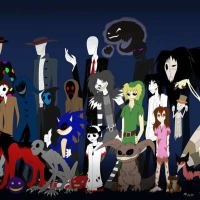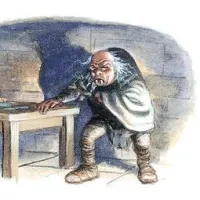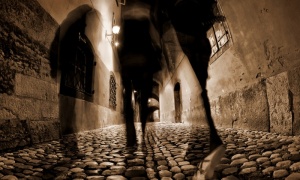The Bogeyman is an imaginary creature commonly used by adults to scare and terrorise children into submissive behaviour by telling them that if they misbehave, the bogeyman will get them. The Bogeyman has no specific appearance in its stories and conceptions about it can vary drastically per nationality or household. Instead he is simply a non-specific embodiment of terror, whose goal depends on what purpose needs serving. Bogeyman tales first made their appearance around the 16th and 17th century. The word “bogey” is probably a variation of the German word bogge, which in turn is a variant of the Middle English bugge, meaning “a frightening spectre”. The earliest modern form of the word was “bogle” (definition: ghost), which was popularised around the 1800’s in English literature and based on the similar Scottish word attested around 1500. The Bogeyman has no specific appearance and conceptions vary drastically by household and culture, but is commonly depicted as a masculine or androgynous monster that punishes children for misbehaviour. Bogeymen may target a specific act or general misbehaviour, depending on what purpose needs serving, often based on a warning from the child’s authority figure. The term “Bogeyman” is sometimes used as a non-specific personification or metonym for terror, and in some cases, the Devil.
Bogeyman-like beings are almost universal, common to the folklore of many countries. In many countries, a bogeyman variant is portrayed as a man with a sack on his back who carries naughty children away. This is true for many Latin countries, such as Brazil, Portugal, Spain, and the countries of Spanish America, where he is referred to as el Hombre del costal, el hombre del saco, or in Portuguese, o homem do saco (all of which mean “the sack/bag man”), or el roba-chicos, meaning child-stealer. Similar legends are also very common in Eastern Europe (e.g. Bulgarian Torbalan, “sack man”), as well as in Haiti and some countries in Asia. El Coco (also El Cuco and Cucuy, sometimes called El Bolo) is a monster common to many Spanish-speaking countries. El ogro (the Spanish word for ogre) is a shapeless figure, sometimes a hairy monster, that hides in closets or under beds and eats children that misbehave when they are told to go to bed. El Sacamantecas (“Fat extractor” in Spanish) is a kind of bogeyman or criminal characterised by killing for human fat and has been used to scare children into behaving.
Germanic folklore has dozens of different figures that correspond to the Bogeyman. These have various appearances (such as of a gnome, man, animal, monster, ghost or devil) and are sometimes said to appear at very specific places (such as in forests, at water bodies, cliffs, cornfields or vineyards). These figures are called by many different names which are often only regionally known. One of these, possibly etymologically related to the Bogeyman, is the Butzemann, which can be of gnome-like or other demonic or ghostly appearance. Other examples include the Buhmann (who is mostly proverbial) and der schwarze Mann (“the black man”), an inhuman creature which hides in the dark corners under the bed or in the closet and carries children away. The figure is part of the children’s game Wer hat Angst vorm schwarzen Mann? (“Who is afraid of the bogeyman?”). In Denmark, the creature is known as the bussemand or bøhmand. It hides under the bed and grabs children who will not sleep. As in the English equivalent, bussemand is also a slang term for nasal mucus. In Norway, he is referred to as the Busemann. In the Netherlands, the Boeman is portrayed as a creature that resembles a man, dressed completely black, with sharp claws and fangs. He hides under the bed or in the closet. The Bogeyman takes bad children or those that refuse to sleep and locks them in his basement for a period of time.
The Bogeyman may be called Boogerman or Boogermonster in rural areas of the American South (“booger” being the American English equivalent of the British English “bogey”), and was most often used to keep young children from playing outside past dark, or wandering off in the forest. During the Corn Festival, young Cherokee males wearing caricature masks would make fun of politicians, frighten children into being good, and shake their masks at young women and chase them around. Male participants in this Booger Dance were referred to as the Booger Men. In some Midwestern states, the boogeyman scratches at the window. In Eastern Iowa he is called the Korn Stalker. In the Pacific Northwest, he may manifest in “green fog”. In other places he hides or appears from under the bed or in the closet and tickles children when they go to sleep at night, while in others he is a tall figure in a black hooded cloak who puts children in a sack. Bloody Bones, also known as Rawhead or Tommy Rawhead, is a boogeyman of the American South. Rawhead and Bloody Bones are sometimes regarded as two individual creatures or two separate parts of the same monster. One is a bare skull that bites its victims and its companion is a dancing headless skeleton.
Bloody Bones tales originated in Britain, which has no shortage of bogeymen (and women) of its own. Black Annis was a hag with a blue face and iron claws who lived in a cave in the Dane Hills of Leicestershire. She ventured forth at night in search of children to devour. Grindylow, Jenny Greenteeth and Nelly Longarms were other grotesque hags who lived in ponds and rivers in the British Isles and dragged children beneath the water if they got too close. These tales emigrated to other parts of the Commonwealth. In Canada The Old Hag is a demonic entity from Newfoundland folklore. According to legend, the Old Hag appears in the bedrooms of naughty children late at night and suffocates them by sitting on their stomachs. The Old Hag then takes the children to her lair in the woods where she eats their bodies. In India the entity is known by different names. In the state of Karnataka, the demon Goggayya (roughly meaning “terrible man”) can be treated as counterpart of the bogeyman. In Tamil Nadu children are often mock-threatened with the Rettai Kannan (“the two-eyed one”), a monster or fearsome man that children are sometimes threatened with if they are not obedient or refuse to eat. In central Kerala, the bogeyman is referred to as Kokkachi, who will take away children for disobeying their parents or misbehaving in any manner.
Throughout the world the bogeyman and its analogues seem to serve similar purposes. For example, the aforementioned myth of the Old Hag in Canada was inspired by experiences caused by Sleep Paralysis, in which an individual would awake to the hallucination of an old woman sitting on them, cutting off their breathing. Similarly, in Russia children are warned that Baba Yaga (a monster, often portrayed as a witch living in the forest, which kidnaps badly behaving children and presumably eats them) will come for them at night if they behave badly. A more modern version of the bogeyman, the Jersey Devil, which originated in the Pine Barrens of New Jersey in the early 18th century, was originally described as having a horse’s head, bat wings, cloven hooves, and a serpent’s tail. Regarding the famous Jersey Devil sightings of 1909, Loren Coleman and Ivan T. Sanderson offered the explanation that they were part of an elaborate real estate hoax, used by developers as a boogeyman figure to frighten residents into selling their property at lower prices. The purpose of the bogeyman seems clear – behave yourself or be prepared to face the consequences!

















I was the kid who talked too much. My mother often told me the story of a skull in a forest who told a similarly talkative boy that “Mouth brought me here and mouth will bring you here too.” Obviously her intent was to get me to shut up. But as an adult I learned the story was an adaptation of one that originated in Africa and was passed down through slave culture and into modern African American storytelling.
Reblogged this on Tripping on Legends.